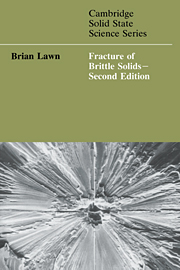Book contents
- Frontmatter
- Contents
- Preface
- Glossary of symbols and abbreviations
- 1 The Griffith concept
- 2 Continuum aspects of crack propagation I: linear elastic crack-tip field
- 3 Continuum aspects of crack propagation II: nonlinear crack-tip field
- 4 Unstable crack propagation: dynamic fracture
- 5 Chemical processes in crack propagation: kinetic fracture
- 6 Atomic aspects of fracture
- 7 Microstructure and toughness
- 8 Indentation fracture
- 9 Crack initiation: flaws
- 10 Strength and reliability
- References and reading list
- Index
Preface
Published online by Cambridge University Press: 14 January 2010
- Frontmatter
- Contents
- Preface
- Glossary of symbols and abbreviations
- 1 The Griffith concept
- 2 Continuum aspects of crack propagation I: linear elastic crack-tip field
- 3 Continuum aspects of crack propagation II: nonlinear crack-tip field
- 4 Unstable crack propagation: dynamic fracture
- 5 Chemical processes in crack propagation: kinetic fracture
- 6 Atomic aspects of fracture
- 7 Microstructure and toughness
- 8 Indentation fracture
- 9 Crack initiation: flaws
- 10 Strength and reliability
- References and reading list
- Index
Summary
This book is a restructured version of a first edition published in 1975. As before, the objective is a text for higher degree students in materials science and researchers concerned with the strength and toughness of brittle solids. More specifically, the aim is to present fracture mechanics in the context of the ‘materials revolution’, particularly in ceramics, that is now upon us. Thus whereas some chapters from the original are barely changed, most are drastically rewritten, and still others are entirely new.
Our focus, therefore, is ‘brittle ceramics’. By brittle, we mean cracks of atomic sharpness that propagate essentially by bond rupture. By ceramics, we mean covalent–ionic materials of various persuasions, including glasses, polycrystalline aggregates, minerals, and even composites. Since 1975, our knowledge of structural ceramics has equalled, some would insist surpassed, that of metals and polymers. But it is brittleness that remains the singular limiting factor in the design of ceramic components. If one is to overcome this limitation, it is necessary first to understand the underlying mechanics and micromechanics of crack initiation and propagation. Prominent among improvements in this understanding have been a continuing evolution in the theories of continuum fracture mechanics and new conceptions of fundamental crack-tip laws. Most significant, however, is the advent of ‘microstructural shielding’ processes, as manifested in the so-called crack-resistance- or toughness-curve, with far-reaching consequences in relation to strength and toughness. This developing area promises to revolutionise traditional attitudes toward properties design and processing strategies for ceramics.
- Type
- Chapter
- Information
- Fracture of Brittle Solids , pp. x - xiiPublisher: Cambridge University PressPrint publication year: 1993



